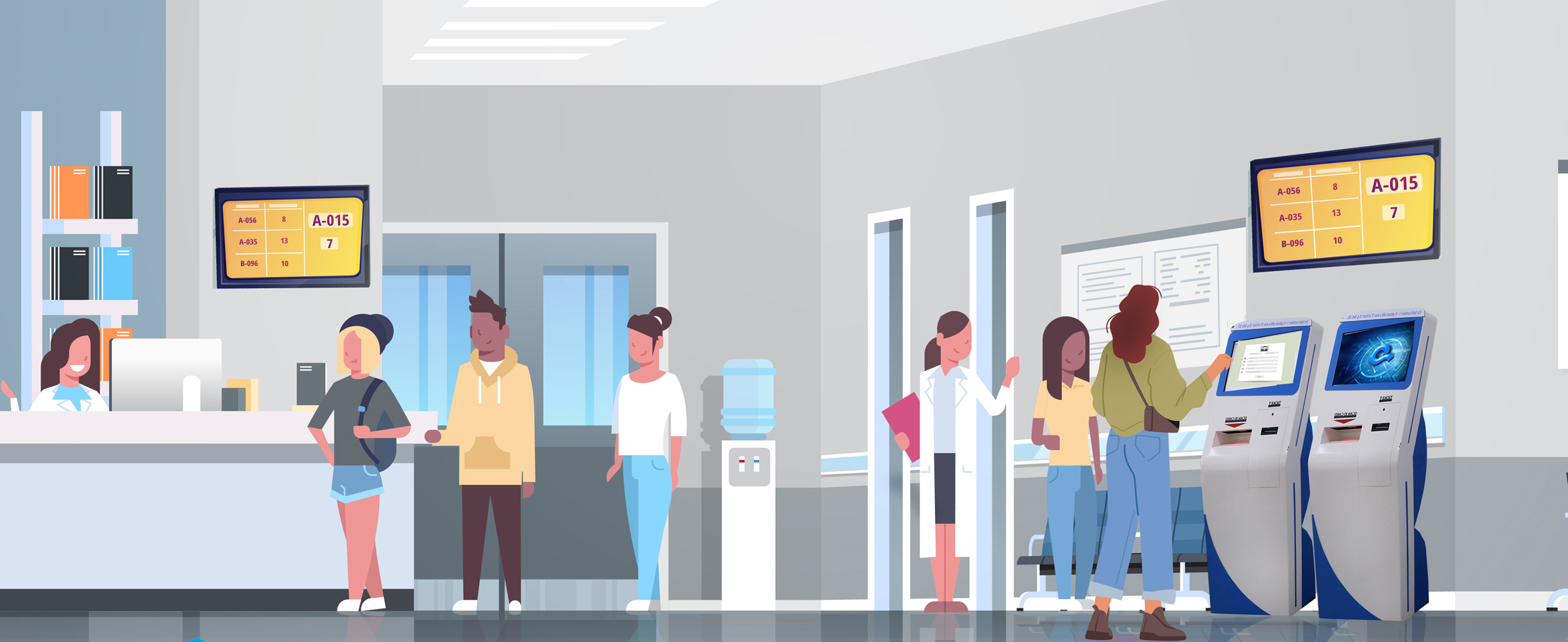
News & Updates

Long queues challenge both customer satisfaction and operational efficiency, particularly in high-traffic sectors like healthcare, banking, government, and retail. Enterprise Queue Management Systems (EQMS) have become essential for organisations determined to slash wait times and deliver swift, seamless service. In this article, we uncover ten proven strategies by which advanced QMS platforms such as ATT Infosoft’s Q’SOFT™ Enterprise Queue Management System consistently reduce waiting times by 50% or more. Drawing on recent innovations in AI, mobile technology, and digital integration, we explore how these solutions drive operational excellence, support regulatory compliance, and enhance customer experiences. Whether you oversee a hospital, service centre, or retail outlet, understanding these QMS-enabled approaches will help your organisation move from outdated, manual queueing to an intelligent, future-ready model one that puts both customers and staff at the heart of service transformation.
1. Automated Customer Flow Allocation
Automated customer flow allocation is a cornerstone of modern QMS platforms, fundamentally changing how organisations manage queues. By removing manual guesswork, these systems dynamically assign customers to the most suitable service points in real time. The result is a dramatic reduction in idle time and a balanced distribution of workloads across all available staff or counters. This approach not only expedites service but also minimises the risk of bottlenecks, especially during peak periods. For environments with multiple services or departments such as hospitals or government agencies automated allocation ensures that every customer is efficiently matched to the right resource, creating a smoother and more predictable flow.
Q’SOFT™ EQMS leverages intelligent automation to achieve this. The system analyses current queue lengths, staff capabilities, and service categories to guide each customer to the best available option. The process is entirely data-driven, allowing for instant adjustments should demand spike unexpectedly. As a result, organisations consistently report faster service delivery, improved staff productivity, and significantly enhanced customer satisfaction outcomes that are essential for maintaining a competitive edge in today’s digital-first service landscape.
AI-Powered Routing Algorithms
Queue management systems equipped with AI-powered routing algorithms take customer flow allocation to the next level. These algorithms continuously process real-time data, such as current queue lengths, staff availability, and the nature of customer requests. By doing so, they determine the most efficient routing for each individual, adapting instantly to changing conditions. According to 2025 industry research, AI-driven allocation has enabled service providers to cut average wait times by as much as 52%. This improvement is especially notable in high-volume settings like hospitals and banks, where every minute saved can translate into greater throughput and elevated customer perceptions.
Dynamic Load Balancing
Dynamic load balancing is another critical feature within advanced QMS platforms. By constantly monitoring demand levels, staff performance, and available service points, the system can evenly distribute customer flow throughout the day. This proactive balancing prevents congestion during peak times and ensures that no single counter is overwhelmed while others remain underutilised. For operations managers, this means better resource planning and the ability to maintain service levels even under pressure. In practice, dynamic load balancing drives both efficiency and fairness, supporting optimal outcomes for both customers and staff.
2. Self-Service Registration Kiosks
Self-service registration kiosks have become a mainstay in customer-centric environments, dramatically accelerating the onboarding process. These kiosks empower customers to check in, select services, and update their information independently, without the need for direct staff intervention. This not only speeds up initial registration but also reduces the likelihood of manual errors that can slow down subsequent service steps. For staff, the automation of routine tasks means more time can be devoted to higher-value or complex interactions, further enhancing productivity and the overall service experience.
ATT Group’s Kiosk Operation Solution (KOS) exemplifies the benefits of this approach. Designed to be modular and adaptable, these kiosks integrate seamlessly with core queue management systems, supporting a wide range of registration and transaction needs. Businesses deploying self-service kiosks consistently report reductions in queue lengths, improved data accuracy, and a noticeable uplift in customer satisfaction. For sectors like healthcare, public services, and retail, this technology is particularly effective in managing high footfall and delivering a modern, contactless experience.
Faster Onboarding
One of the most immediate advantages of self-service kiosks is the speed of onboarding. Customers can enter their details, select their required service, and receive a queue number within seconds, bypassing the delays often associated with manual check-ins. Recent studies from 2024 and 2025 highlight that self-registration processes can reduce check-in times by up to 70%, making it possible to serve more customers in less time. This rapid onboarding is crucial during busy periods and helps set a positive tone for the entire service journey.
Multilingual and Accessible Interfaces
Inclusivity is a key consideration in kiosk design. Leading self-service kiosks, including those offered by ATT Group, feature multilingual interfaces and accessible design elements to cater to diverse customer groups. Whether serving non-native speakers, elderly individuals, or persons with disabilities, these kiosks minimise confusion and reduce delays. Enhanced accessibility ensures that every customer can interact confidently with the system, supporting compliance and delivering a superior, universally accessible experience.
3. Online Appointment Scheduling
Online appointment scheduling has become a game changer for organisations seeking to manage customer flow proactively. By allowing clients to pre-book visits and select convenient time slots, online systems drastically reduce the unpredictability of walk-in surges and enable precise resource planning. Integrated with QMS platforms, these systems empower businesses to optimise their daily operations, align staffing with demand, and deliver a more personalised service experience.
ATT’s Online Appointment System (OAS) is a robust, cloud-enabled solution that exemplifies this approach. The OAS streamlines the booking, rescheduling, and cancellation process, making it straightforward for customers to manage their appointments from any device. With AI-driven logic, the system continuously optimises slot allocation, ensuring maximum efficiency and balanced traffic loads. By integrating OAS with queue management, organisations gain a powerful tool for reducing wait times, improving staff utilisation, and enhancing customer satisfaction all while maintaining full visibility and control over service delivery.
24/7 Booking Access
One of the standout advantages of online appointment systems is their round-the-clock availability. Customers can schedule appointments at their convenience, even outside of standard business hours. This flexibility smooths out arrival patterns, reduces the rush typically seen at opening times, and helps organisations better manage capacity. For sectors such as healthcare and government, 24/7 access is instrumental in delivering equitable and efficient service to all users.
Automated Reminders and Confirmations
Automation doesn’t stop at booking. Integrated QMS platforms send automated SMS and email reminders to customers ahead of their appointments, significantly reducing the incidence of no-shows. Confirmations help clients arrive on time, which in turn creates a steadier flow and greater operational predictability. With less disruption from missed appointments, staff can operate more effectively, and wait times remain consistently low.
Real-Time Slot Management
Real-time slot management is another vital feature. As soon as an appointment is booked, rescheduled, or cancelled, the system updates available time slots instantly. This prevents overbooking and allows immediate reallocation of resources when openings arise. The result is optimal use of staff and service points, minimising idle periods and ensuring that every available slot is utilised efficiently for the benefit of both the organisation and its customers.
4. Mobile Queue Ticketing and Notifications
Mobile queue ticketing has rapidly gained popularity as organisations seek to enhance convenience and reduce perceived wait times. QMS platforms now issue virtual queue tickets and provide live status updates directly to customers’ mobile devices. This innovation eliminates the need for physical queueing, allowing individuals to wait comfortably in nearby spaces or even offsite until their turn arrives. The result is not only improved comfort but also increased safety, as congestion at entry points is minimised.
ATT Group’s solutions support this mobile-first approach, enabling contactless check-in and real-time notifications that keep customers informed at every stage. By reducing the need for physical presence in waiting areas, mobile ticketing contributes to a more streamlined and enjoyable service journey. This feature has become especially valuable in 2025, as customers now expect digital convenience and flexibility as standard.
Contactless Check-In
Contactless check-in is a defining feature of modern mobile-enabled QMS platforms. Customers simply scan a QR code or use a mobile app to join the queue, bypassing traditional registration desks altogether. This process supports safer, touch-free experiences an essential consideration for sectors prioritising public health and hygiene. For businesses, contactless check-in reduces congestion at entry points and ensures that staff can focus on delivering quality service rather than managing queues manually.
Live Queue Updates
Live queue updates delivered via push notifications keep customers informed about their position in the queue and estimated wait times. As their turn approaches, they receive timely alerts, allowing them to return to the service point without unnecessary waiting. This feature not only enhances comfort but also reduces perceived wait times, as customers can make better use of their time while remaining confident they won’t miss their slot.
5. Predictive Analytics for Staffing
Predictive analytics is transforming workforce management in queue-driven environments. Advanced QMS platforms harness the power of real-time data and historical trends to forecast busy periods and optimise staff scheduling. This ensures that service points are always adequately resourced, particularly during demand spikes, enabling faster throughput and consistently short wait times.
ATT Group’s Q’SOFT™ EQMS leverages predictive analytics to provide supervisors with actionable insights into queue dynamics and service patterns. By anticipating surges and aligning staffing accordingly, organisations can maintain high service standards even under pressure. The result is not only improved efficiency but also greater staff satisfaction, as workloads are balanced and manageable throughout the day.
Real-Time Data Dashboards
Supervisors and managers benefit from real-time data dashboards that display live analytics on queue lengths, service times, and customer arrivals. These dashboards enable swift, data-driven decisions about staffing or counter assignments, ensuring the right resources are deployed exactly when and where they are needed. In fast-paced environments, access to live insights is critical for maintaining operational agility and minimising delays.
Historical Trend Analysis
Historical trend analysis is another powerful tool within predictive analytics. By examining patterns from previous days, weeks, or months, the system identifies recurring peak times and supports more accurate resource planning. This forward-looking approach enables better shift rotations, prevents understaffing, and ensures consistent service quality regardless of fluctuations in demand.
6. Service Segmentation and Priority Queues
Service segmentation and priority queues are vital for managing diverse customer needs efficiently. By categorising customers according to service type or urgency, QMS platforms direct individuals to dedicated counters or fast lanes, significantly reducing wait times for high-priority cases while maintaining steady flow for all others. This approach is particularly valuable in settings where some transactions are inherently quicker or certain groups require expedited service.
ATT Group’s queue solutions are fully configurable to support tailored service segmentation, enabling organisations to design workflows that reflect their specific operational requirements. Whether fast-tracking routine transactions or providing priority access for vulnerable groups, these systems ensure fairness, compliance, and optimal throughput across the board.
Express Lanes for Simple Transactions
Express lanes are designed to handle routine tasks such as document pick-up or quick payments, allowing customers with straightforward needs to bypass longer queues. By segmenting these simple transactions, organisations can ensure that all customers experience shorter waits and faster service. This not only boosts satisfaction but also frees up resources for more complex or time-consuming requests.
Priority Handling for Special Groups
Priority queues are essential for inclusivity and compliance. Vulnerable groups such as the elderly, pregnant women, or persons with disabilities benefit from dedicated service lanes that minimise their waiting time. By ensuring swift and respectful treatment for these individuals, organisations demonstrate their commitment to accessibility and social responsibility while also maintaining regulatory standards.
7. Integration with Digital Payment Solutions
Integrating QMS platforms with digital payment solutions streamlines the service journey from start to finish. Customers can complete transactions quickly at self-service kiosks or via mobile, reducing the total time spent onsite and eliminating the bottlenecks associated with manual payment processes. This integration is especially valuable in high-volume environments where speed, accuracy, and security are paramount.
ATT Group’s Payment Services Solution is designed to modernise and automate collections, supporting secure, efficient, and real-time processing. By linking payment with queue management, organisations accelerate customer turnover, reduce operational risks, and achieve better audit transparency. This seamless experience not only cuts wait times but also reinforces trust and satisfaction among users.
Frictionless Checkout
Frictionless checkout enables customers to settle payments instantly, without waiting for staff assistance. Automated payment modules at kiosks or within mobile apps eliminate the need for manual cashiering, supporting faster customer turnover and reducing errors. This streamlined process is critical for maintaining flow and optimising the end-to-end service experience.
Secure, Multi-Channel Transactions
Modern digital payment platforms offer customers a variety of secure options, including card, e-wallet, and mobile payments. By catering to diverse preferences, QMS-integrated payment solutions speed up transactions and improve throughput. Enhanced security features also protect both organisations and users, ensuring confidence in every transaction.
8. Real-Time Performance Monitoring
Continuous, real-time performance monitoring is essential for maintaining high service standards and minimising wait times. QMS platforms equipped with live dashboards and automated alerts empower supervisors to respond instantly to unexpected surges or slowdowns. This level of oversight ensures that corrective actions can be taken before minor issues become major bottlenecks.
ATT Group’s solutions provide comprehensive monitoring tools, delivering actionable insights on queue metrics and service performance. By fostering a culture of responsiveness and continuous improvement, these platforms enable organisations to adapt swiftly and maintain optimal customer experiences at all times.
Automated Threshold Alerts
Automated threshold alerts notify supervisors immediately when queue times exceed predefined limits. These instant notifications prompt rapid responses, such as opening additional counters or reallocating staff, preventing delays from escalating. This proactive approach keeps service levels consistent and ensures customers are attended to promptly, even during unexpected demand spikes.
Continuous Improvement Loops
Performance data collected by QMS platforms feeds into ongoing process reviews, supporting incremental refinements to service delivery. By identifying patterns and pinpointing areas for enhancement, organisations can implement targeted improvements that further reduce wait times and elevate the overall customer experience. This data-driven approach is fundamental to achieving operational excellence in 2025 and beyond.
9. Customer Feedback Integration
Real-time customer feedback is a powerful driver of continuous improvement. QMS platforms now routinely prompt users for feedback after their service interaction, providing organisations with immediate insights into pain points and opportunities for enhancement. By actively listening to customers, businesses can identify and address issues before they impact wider satisfaction or operational efficiency.
ATT Group’s queue solutions are designed to facilitate this feedback loop, integrating digital surveys and analytics directly into the service journey. The result is a more responsive, customer-focused approach that supports ongoing reductions in wait times and measurable improvements in user experience.
Instant Post-Service Surveys
Short, digital post-service surveys capture customer sentiment while the experience is still fresh, ensuring authentic responses and actionable data. These surveys are quick to complete and can be tailored to specific service touchpoints, making it easy for organisations to gather targeted feedback across all customer segments.
Feedback-Driven Adjustments
Supervisors and managers use feedback analytics to identify recurring issues and implement timely adjustments to service protocols or staffing levels. Over time, this process leads to more efficient operations, as customer insights directly inform decision-making and resource allocation. The ongoing integration of feedback ensures that wait times continue to decrease, even as customer expectations evolve.
10. Seamless Integration with Existing Systems
Seamless integration with existing IT ecosystems is a defining feature of enterprise-grade QMS platforms. By connecting with visitor management, appointment scheduling, and resource planning tools, these systems eliminate data silos and streamline the entire customer journey. This unified approach ensures that every touchpoint from arrival to departure is optimised for speed, accuracy, and convenience.
ATT Group’s Q’SOFT™ EQMS and its broader suite of enterprise IT solutions are engineered for interoperability, supporting both on-premise and cloud-based deployments. Open API architecture and modular design enable easy integration with HR, CRM, or ERP systems, ensuring that queue management enhances rather than disrupts established workflows. The result is a holistic, future-ready service environment that supports rapid digital transformation and sustained operational excellence.
Unified Data Ecosystems
Unified data ecosystems synchronise all customer interactions, whether digital or in-person, providing staff and management with comprehensive visibility. This integration eliminates duplicate data entry, reduces errors, and enables coordinated responses across departments. For organisations seeking to deliver consistent, high-quality service, unified ecosystems are a critical enabler.
Flexible API Architecture
Flexible API architecture allows QMS platforms to integrate easily with a wide range of enterprise applications. Whether connecting to HR systems for staff scheduling or CRM platforms for customer engagement, open APIs ensure that new capabilities can be added without disrupting existing processes. This adaptability is essential for organisations operating in complex, regulated environments and looking to future-proof their service delivery.
Reducing Wait Times: The Case for Intelligent Queue Management
Queue Management Systems are now indispensable for organisations committed to delivering efficient, customer-focused service in 2025. Through automation, predictive analytics, and seamless integrations, QMS platforms reliably cut wait times by half or more transforming both operational outcomes and customer perceptions. ATT Group’s suite of intelligent queue solutions empowers businesses across healthcare, government, and retail to achieve operational excellence, support regulatory compliance, and build enduring trust with their clients. For any organisation looking to create the difference in service delivery, investing in advanced queue management is not just an option it’s a strategic imperative.
Send us a message
Contact Information
Address:
35 Ubi Crescent, ATT Building, Singapore, 408585
Phone:
Email:
Website:
www.attsystemsgroup.com












